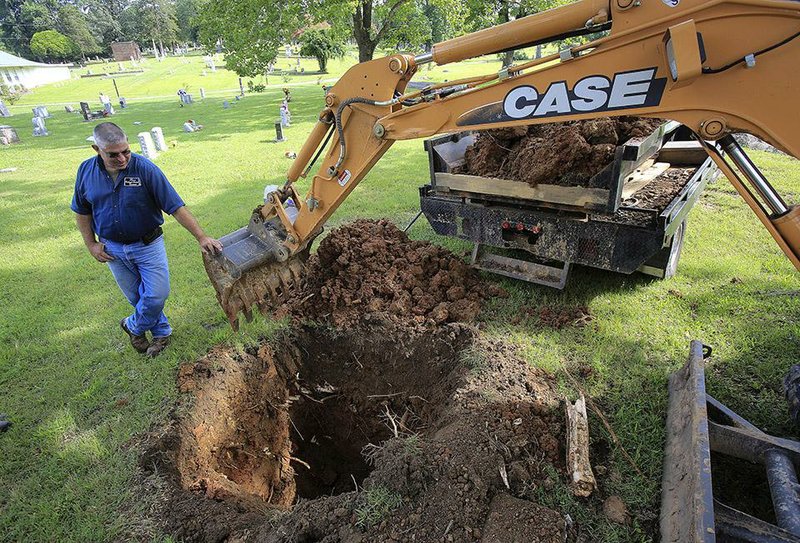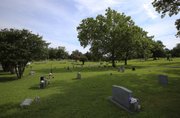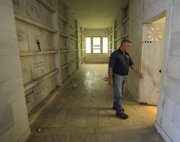John Rains knew he had a problem when he found the bone.
It was Dec. 15, 2012. He was 4½ feet deep in the ground, digging a grave at the Oakland-Fraternal Historic Cemetery in east Little Rock. And this grave site was supposed to be empty.
Rains, the cemetery's caretaker, reached down and brushed away the dirt for a closer look. The bone appeared to be human. Next to it was a wooden sliver that resembled the remains of an old casket.
Someone else is buried here, he thought.
Rains took his concerns to the cemetery's historian. The two soon unearthed a much larger concern.
Rains found the bone in a newer section of the cemetery called Center Addition. More than 70 people had been buried there between the late 1990s and 2012, their graves marked with headstones.
More than 100 other spaces in the section had been purchased for burials as well.
But Rains and cemetery historian Jan Hearn Davenport found cemetery records and an old map that showed the newer graves were right in an old potter's field, an area where thousands had been laid to rest in unmarked graves for at least 100 years.
The two took their discovery to the cemetery's board, which stopped burials in the Center Addition and began debating what else it needed to do.
The cemetery's former manager, who laid out Center Addition and dug most of the graves there, says he never encountered any remains to suggest the newer burials are mixed in among older ones.
But Rains and Davenport said they're confident in their evidence.
They've spent months gathering the clues, and Exhibit One is the old map that hangs in the cemetery's office.
Covered maps
On a hot day last June, Davenport leaned forward in her chair inside the small cemetery office and explained her find.
A dogged researcher, Davenport enjoys combing the cemetery's files and markers in search of a good story.
That's why Rains went to Davenport after he unearthed the bone. And why Davenport quickly went to the old map from 1917 on the north wall of the cemetery office.
A portion near the map's bottom had always stood out to her. It was the only bright white space on the otherwise yellowed map.
In the middle of the space is a bold, black label. Section G.
She compared the section to a newer map of the cemetery that hangs nearby. Section G matched up to Center Addition.
Next Davenport went to the cemetery's big red registry of lots, a handwritten record that dates back more than a century.
Near the back, she found the page for Section G. The title of the page jumped out to her -- paupers.
Davenport had always known the cemetery had a potter's field. There were thousands of names in another of the cemetery's books noting pauper burials, some as recent as the 1980s. But they didn't list specific burial spaces.
The potter's field was supposed to have been near where a flagpole stands today, farther south from where Rains found the bone, she recalled.
But the streets in the registry's paupers section matched the layout of the almost 2-acre Section G.
And according to the maps, Center Addition should sit on about a quarter acre of Section G, across a small road from the cemetery's office. Davenport could glance out the window and see the headstones.
"The moment I put it together, that's when I said, 'Huh uh,'" Davenport recalled.
Stranger's Hollow
The existence of the potter's field traces back to the 1860s when the separate Oakland and Fraternal cemeteries were created.
Whites were mostly buried in portions of Oakland cemetery. Blacks were mostly interred in Fraternal, where members of several black organizations, including the United Order of Odd Fellows and the Mosaic Templars of America, are buried, according to historical research summarized in the cemetery's nomination for inclusion on the National Register of Historic Places.
Over the years, the two cemeteries became the final resting place for all manner of people -- Union and Confederate veterans, governors, senators and the social elite of Little Rock as well as shopkeepers, business owners, lawyers and laborers, according to the register research.
But like nearly every town or city in the 1800s, a portion of the cemetery was set aside to bury the indigent. The space was called various names over the years, including Pauper Grounds, Public Ground and Stranger's Hollow.
Cemetery records show that both whites and blacks were interred there -- men, women and children too poor to afford a burial space -- often in wooden boxes or sometimes just sheets.
People who died while traveling through Little Rock during the late 1800s and early 1900s also were interred there, when identifying a lone traveler could be difficult, let alone finding family members miles or states away.
The graves were unmarked, but not all of those paupers would have been buried where Center Addition sits. In fact, many pauper graves were covered up with several feet of fill dirt more than 25 years ago in a land deal with Little Rock National Cemetery.
Land deal
In 1985, the adjacent National Cemetery was running out of room for veterans burials. A newspaper article from that September noted that the nonprofit Little Rock National Cemetery Expansion Corp. had begun looking to acquire a handful of acres from Oakland-Fraternal, which is owned by the city.
The sale took three years to finalize, and in 1988, the nonprofit purchased about 4.78 acres from the city for about $60,000. The nonprofit later acquired nearly another acre and donated the almost 6 acres to the National Cemetery for veterans burials.
According to city documents, the 4.78 acres were noted as "unused" on the March 1988 resolution authorizing its sale. But an editorial by Robert McCord in the Arkansas Gazette noted some complications with the land.
"For years Oakland Cemetery allowed a part of this land to be used for the burial of body parts surgically removed at St. Vincent Infirmary according to the dictates of the Roman Catholic Church, which operates the hospital," McCord wrote.
The 1989 editorial notes that "the practice stopped many years ago, but the existence of these body parts and their disposal will cause delay."
A year later, in a follow-up article, David Glamm, a veteran and the head of the Little Rock National Cemetery Expansion Corp., said the newly acquired land also contained paupers' graves.
"No graves are going to be disturbed. We're going to leave them be," Glamm said.
The article from June 1990 gave "general parameters" of the unmarked graves as covering about an acre of a "flood-prone area." The area is "clearly marked on a map," the article notes, without elaboration.
Glamm and Frank A. Smith, then the Oakland-Fraternal board president, who were quoted extensively in articles in the Gazette and the Arkansas Democrat about the cemetery expansion, have since died -- Glamm in 2003, and Smith in 2012.
So has Roy Beard Sr., a longtime manager at the cemetery from the mid-1960s through the 1990s.
His grandson, Doug Beard, said he remembers that several feet of fill dirt were put over the top of the potter's area, where neat rows of veterans graves are today.
Beard, who served as the cemetery board's president from the mid-1990s through 2005, also remembers Center Addition being laid out, but he doesn't remember any pauper graves there.
Bo Pilkington, who managed the cemetery from 1989 to 2007, doesn't either.
He laid out Center Addition in the mid-1990s, and over the next several years, dug dozens of graves in the new section.
"I never hit any remains in the burials that I did there. I never hit anything," he said in an interview.
The cemetery records he consulted at the time didn't show any burials in Center Addition, he said. And all of the paupers he buried during his time at the cemetery were in other sections of the cemetery.
When asked about Rains' discovery of the bone, Pilkington acknowledged it was possible there were older graves there, but said they would have been buried long before he took over as manager.
"If they found something, then maybe it's a possibility there was. But I personally never dug into anything that was inside the Center Addition," he said.
Breaking ground
All through 2014, the cemetery board has struggled with what it should do to find out whether Center Addition contains unidentified remains.
Earlier in the summer, it commissioned Rains to conduct a test dig in one grave listed as being empty. The grave was near the mausoleum, which sits just south of Center Addition and also within old Section G.
Rains and veteran gravedigger Bill Rhodes didn't find anything.
But in August, workers trying to stabilize the deteriorating mausoleum needed to dig more holes.
The stabilization work -- funded in part by a $72,000 grant from the Arkansas Historic Preservation Program -- called for excavation around the building to redirect runoff.
Because of the potential for unmarked remains, the Historic Preservation program had Dr. Elizabeth Horton, an archaeologist with the Arkansas Archaeological Survey, monitor the digging.
On a searing August day, the workers started on the other side of the mausoleum, away from Center Addition.
About 4 feet down, Horton motioned for the backhoe operator to stop, because mottling in the soil began to make her suspicious. She motioned for the backhoe to dig a little farther. A final scoop unearthed a stretch of dark gray stains.
Horton and her crew put on protective gear -- diseases such as tuberculosis can live for years in soil and can pose a danger -- and after discussion and examination, she made a decision.
"We confirmed without any doubt the presence of unmarked burials," she said in a later interview. Three burials she said were "definitive" and a fourth was "highly likely."
No remains were exhumed or disturbed any further, and a new plan for stabilizing the mausoleum that doesn't involve any digging was put in place to avoid unearthing any other remains.
Horton said the presence of the remains strongly indicated that there could be more unmarked burials around the mausoleum and possibly in the graves in the Center Addition.
Or as she put it: "The other side is likely."
What now?
After Horton's findings and more evidence of unmarked burials on the east side of the mausoleum, cemetery board members knew they had to act.
State law forbids the intentional burial of someone in a place suspected of already holding another corpse.
But the board also knew the solution could be costly, particularly for a cemetery that has struggled financially. Even though the cemetery is city-owned, it operates largely on its own.
At the November meeting, board members were nearly jubilant to learn that they would be operating next year with a deficit of less than $100,000.
To make matters worse, both of the cemetery's main bridges have been closed for more than a year because of structural problems. The closed bridges force visitors to detour through the nearby Jewish cemetery and creep along crumbling roads to find the Oakland-Fraternal office, which has hurt business, board members say.
After several rounds of discussion that at times turned heated, the cemetery board met last month to finalize a plan presented by board chairman John Bush.
The board would allow plot owners to swap their spaces for others in the cemetery free of charge. The cemetery also would buy back spaces from owners who decide they want to be buried somewhere else.
Those were the easy proposals.
A third one pertained to a much more difficult situation signified by squares of orange highlighter on a new map in the boardroom. These spaces marked where someone has been buried but whose still-living family members wish to be buried next to them. Family members still wanting to honor those wishes would need to exhume their loved ones and move them to another site.
Board member Helen Hronas favored having the cemetery bear the cost of disinterment if needed.
"I think we just have to eat it. It's the cemetery's mistake," she said.
Board member Scott Shepard agreed, but urged bringing in an archaeologist to check out each grave to see if it can be used before deciding to exhume.
But other board members balked at footing the entire bill or paying for an archaeologist.
Bush presented an alternative. The board would waive any labor costs for Rains' work on disinterments.
But the family should have to pay for the other costs, which includes hiring a funeral director and in total, could involve a few hundred or even a few thousand dollars.
The board voted 6-1 with two abstentions to approve Bush's plan.
Moving on
The board's decision meshed with how Bush has appraised the situation in Center Addition since he learned of it.
He doesn't know why it happened. He'd rather focus on the future and make sure the mistakes of the past aren't repeated.
"It's a complex issue. It's unfortunate," Bush said.
"I don't think anybody in hell would have done this deliberately," he added.
But Rains and Davenport are more skeptical.
"I think it would be highly unlikely that a burial could have been done out in the potter's field and not come across any human remains, whether it be bones, wooden pieces or a shroud," Rains said.
Davenport agrees.
She is continuing to catalog the names of the paupers. She's also continuing research to try to find out exactly what happened in Center Addition.
"Each family is going to deal with this in different ways," Davenport said. "Some are going to be angry."
For Rains, the matter is simple. He's going to make sure those buried in the unmarked graves aren't disturbed.
"I'm not going to look the other way," he said. "None of this should have happened."
He's said the same thing since he found the bone.
Rains finished that burial in the potter's field. But it was the last one.
Information for this article was contributed by Michelle Goad of the Arkansas Democrat-Gazette.
SundayMonday on 01/04/2015


